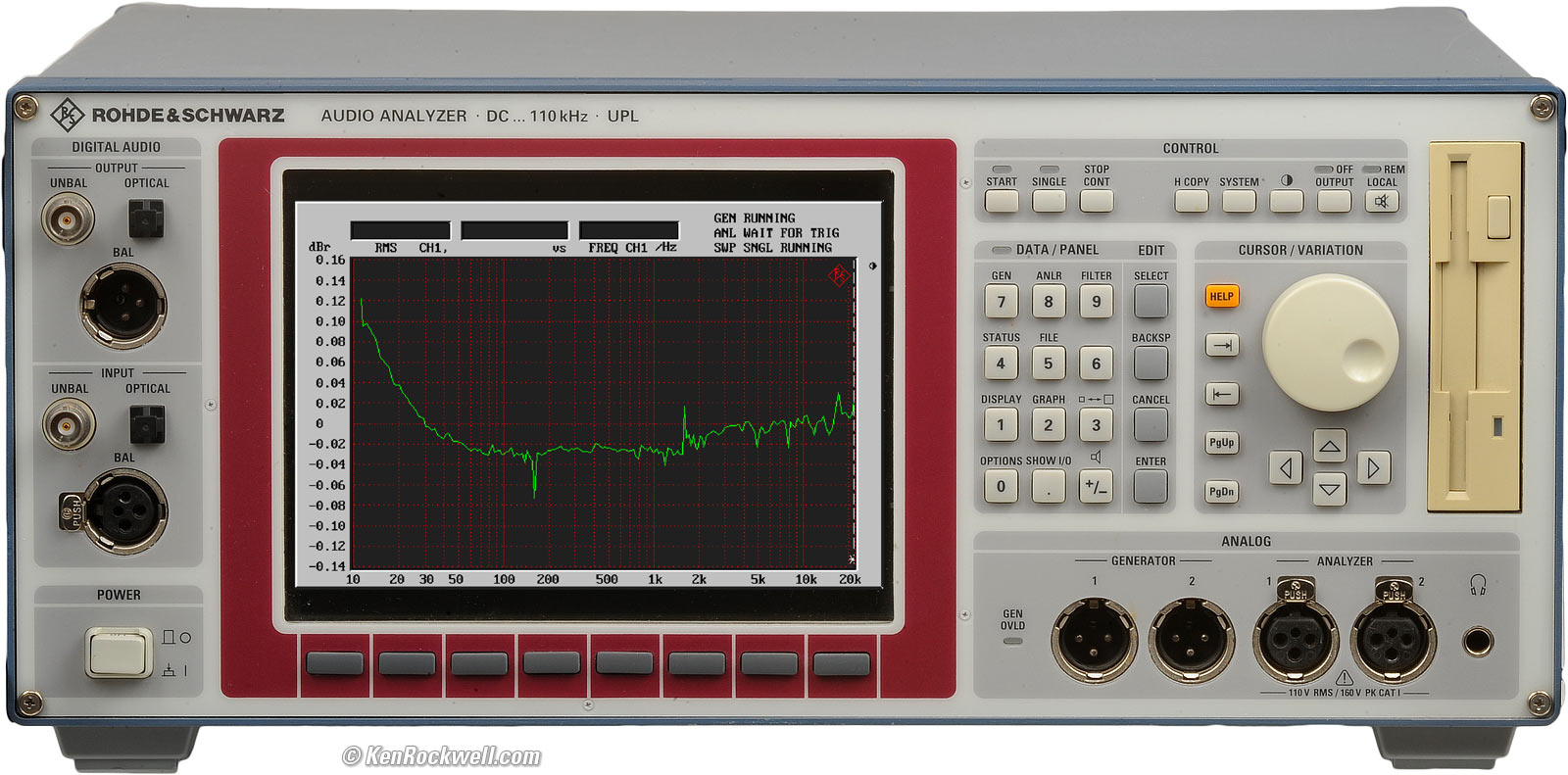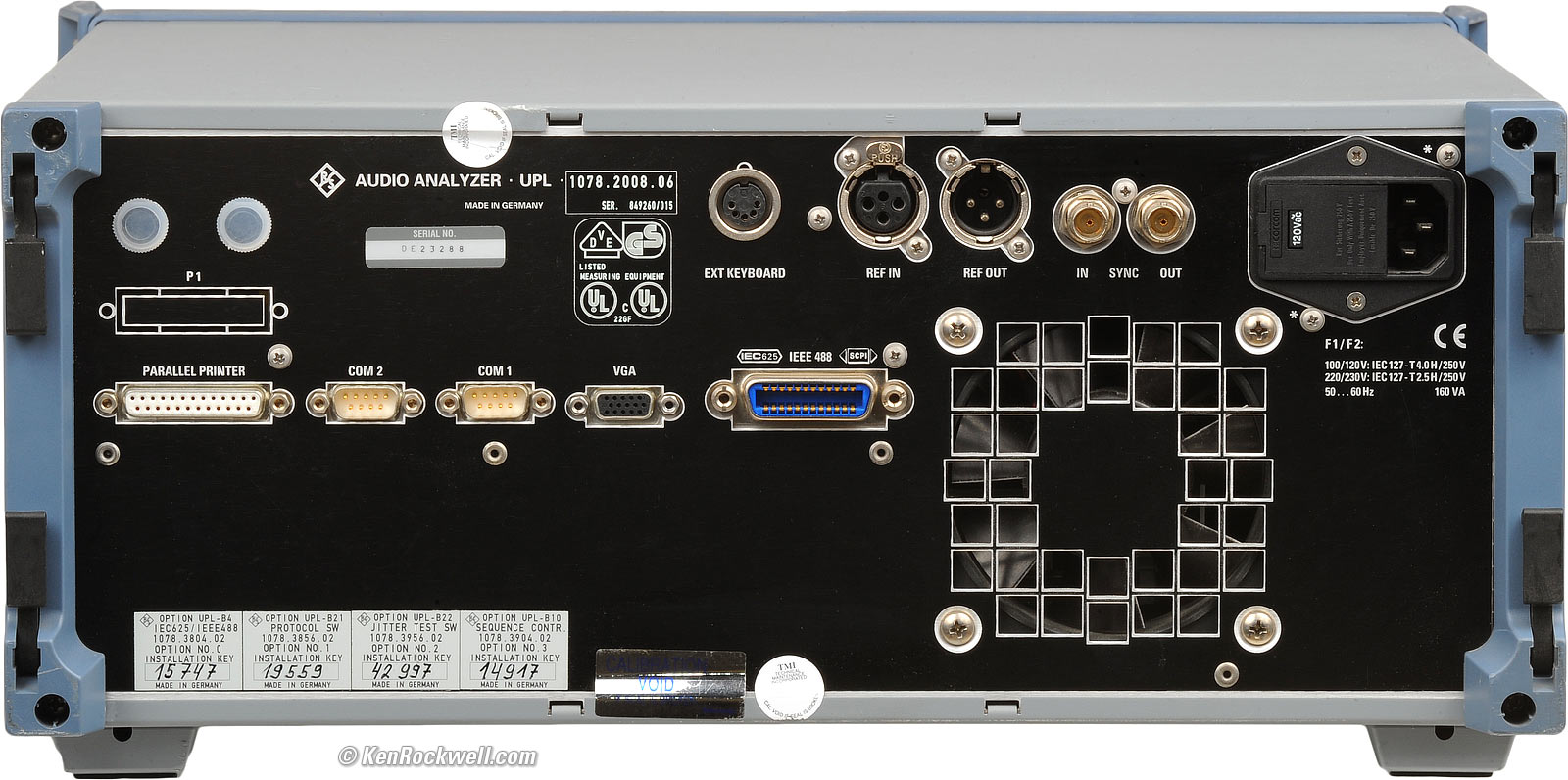Home Donate New Search Gallery Reviews How-To Books Links Workshops About Contact
Rohde & Schwarz R&S UPL
0.00003% THD, DC-110 kHz (1996-2008)
![]()
Rohde & Schwarz UPL. enlarge.
Rear, Rohde & Schwarz UPL. enlarge. (about $10,000 used, depending on options).This free website's biggest source of support is when you use these links, especially this link directly to the R&S UPL at eBay (see How to Win at eBay), when you get anything, regardless of the country in which you live.
This sample actually came from Recon Test Equipment, (866) 855-0960, who offer not only great prices, but also extraordinary service and availability. This one shipped out and arrived overnight from across the country, and came fully calibrated and warranted. Recon Test can usually locate exactly what you need if you ask, and let them know I referred you if you get anything. They're also looking to expand their inventory if you have any no-longer-needed test equipment. Thanks! Ken.
November 2021 Audio Reviews All Reviews
The MADE-IN-GERMANY Rohde & Schwarz UPL is among the world's greatest laboratory audio analyzers. It's so stable that it has a two-year calibration cycle. It has state-of the-art-performance for both analog and digital measurements.
When introduced in 1996, the UPL was the "light" version of the state-of-the-art R&S UPD. Today, this UPL is exceeded only by the newest state-of-the-art R&S UPV. This UPL has the same audio performance as today's UPV, differing mostly in the internal computer used to control everything. An advantage of the simpler operating system of this UPL is that the entire instrument boots and is making complex measurements in less than 50 seconds from power-on!
If you're an individual who demands the highest possible audio performance, the UPL cannot be exceeded, and its used price is a bargain at only about $10,000. They sold new for about $40,000, well optioned.
A new UPV makes more sense for large organizations as it uses a more modern operating system, USB communication and CD/DVD drives, and is easy to order new, optioned for your exact needs, however the audio performance of the UPL and UPV are identical.
If you're running a laboratory on a shoestring, a used UPL offers the world's best laboratory audio performance, all in one box without needing any more computers or screens.
External sound cards like the American-made AP 2700 series have almost similar performance on paper, but they aren't stand-alone instruments and instead require a separate outboard computer. Actual performance of sound-card based analyzers often is much less when RFI and EMI from the PC is considered. R&S has been a specialist in radio, EMI and RFI design since they were founded in 1933, and has done extensive work in these instruments to ensure that the internal computers do not interfere with anything.
R&S audio analyzers are made without compromise. They are the world's best, and priced accordingly, so you don't often see them. Unlike Mercedes-Benz today, R&S is still a privately-held company run to make the world's very best laboratory equipment at any price, not to flood the market with less expensive products. You won't fully appreciate Rohde & Schwarz until you try to lift one of these heavy beasts of precision engineering: mechanics and RF shielding are very important to R&S as well. R&S equipment is still built to last a lifetime from a company that exists to build the best equipment, not to pander to investors.
The reason I'm so familiar with R&S, and specifically the UPL, is that I worked for the US company who represented R&S in the USA when the UPL was first introduced (Tektronix); R&S today has its own USA division.
WARNING: This is a professional laboratory instrument. If you lack the appropriate professional qualifications, you probably won't kill yourself working with this, however meaningful measurements require a great deal of skill to set up and perform. This is not a consumer device. Skill level required: Design Engineer, BSEE minimum degree.
![]()
The rest of this are notes to myself as I complete this review. Please read accordingly.
Performance top
Intro Specs Performance Compared Usage Recommendations
All these performance measurements are analog out to analog in.
Digital-to-digital measurements are pretty much perfect (it's just crunching numbers), and any mixed-mode tests would be testing the external converter that would be needed to change domains.
-130 dB / 0.00003% THD @ 1 kHz
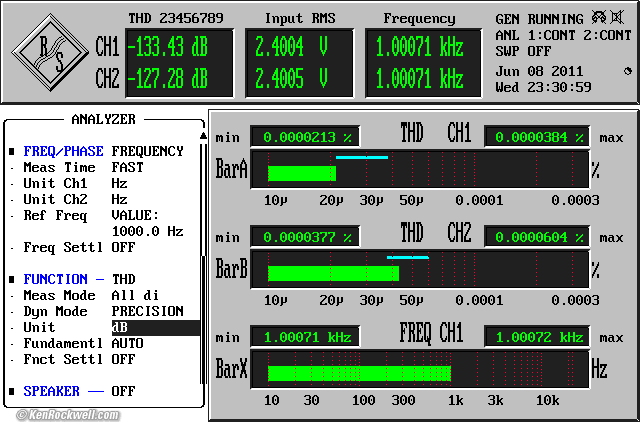
THD at 1 kHz at 2.4V RMS, UPL low-distortion generator, balanced 600 Ω output, generator crossed AC input as read by UPL analyzer, 22 kHz bandwidth.
Frequency Response
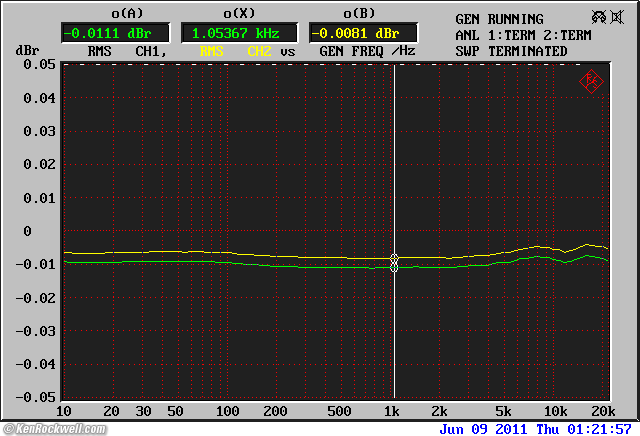
Frequency Response, UPL standard generator at 1 V RMS as read by UPL analyzer, DC-coupled, generator crossed, 10 Hz - 22 kHz. Channel 1 and Channel 2.
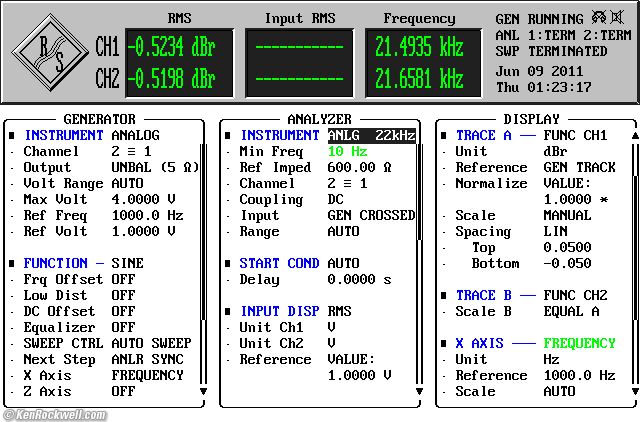
Setup for above.
Here's the actual response through a 99¢ stereo RCA cable:
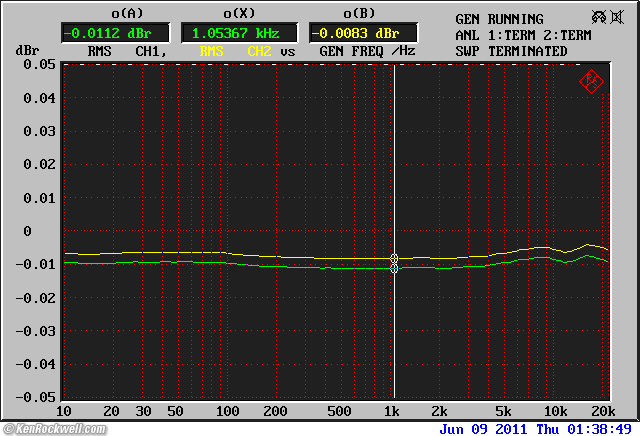
Actual measured intrinsic frequency Response, UPL standard generator at 1 V RMS as read by UPL analyzer, DC-coupled, unbalanced 5 ohm output, RCA adapters into balanced inputs, 200 k ohm float, 10 Hz - 22 kHz. Channel 1 and Channel 2.
If that's not flat enough, R&S provides a setup file to get response this flat:
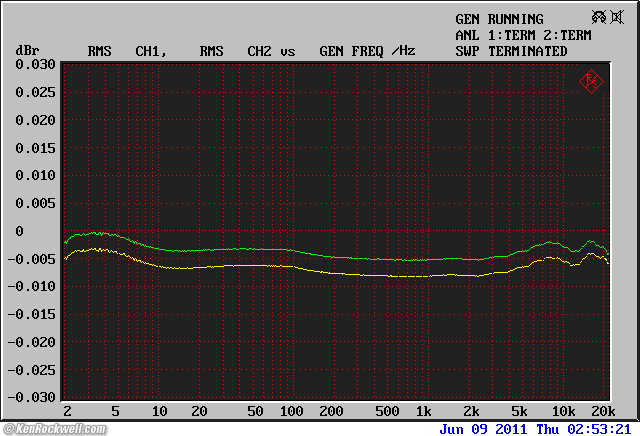
Ultraflat Frequency Response, R&S' FLAT_GEN.SAC and related files, generator as read by UPL, 2Hz - 22 kHz. Channel 1 and Channel 2.
For flatter results, one can store this curve as a calibration reference for even flatter response!
If you want to read down to 0.1 Hertz (one cycle every 10 seconds or 100 milliHertz), no problem, just set the generator's start frequency to 0.1 Hz:
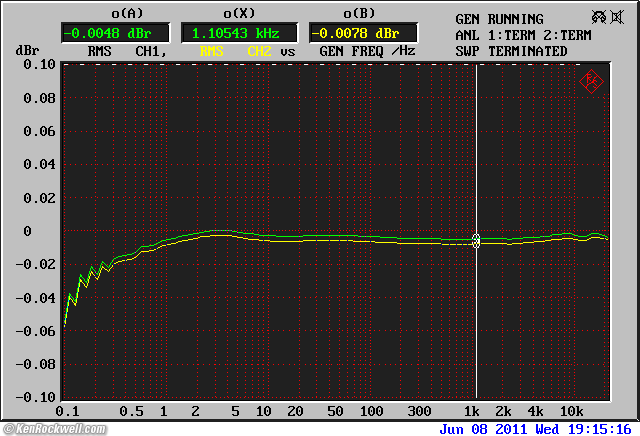
Actual measured intrinsic frequency Response, UPL standard generator at 1 V RMS as read by UPL analyzer, DC-coupled, unbalanced 5 ohm output, RCA adapters into balanced inputs, 200 k ohm float, 0.1 Hz - 22 kHz. Channel 1 and Channel 2.
At ultralow frequencies, the UPL is measuring slopes and slew rates to get amplitudes, so it sweeps through these quite quickly without having to wait for complete cycles.
Here's the response of the AC-coupled input:
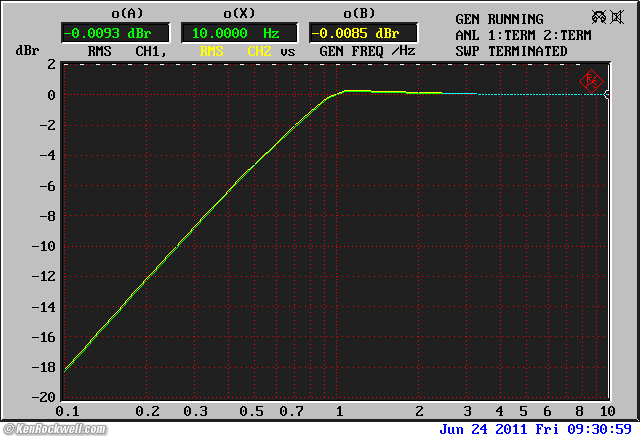
AC-coupled Input response, unbalanced 5 ohm output, RCA adapters into balanced inputs, 200 k ohm, 0.1 Hz - 10 Hz. Channel 1 and Channel 2.
THD versus frequency
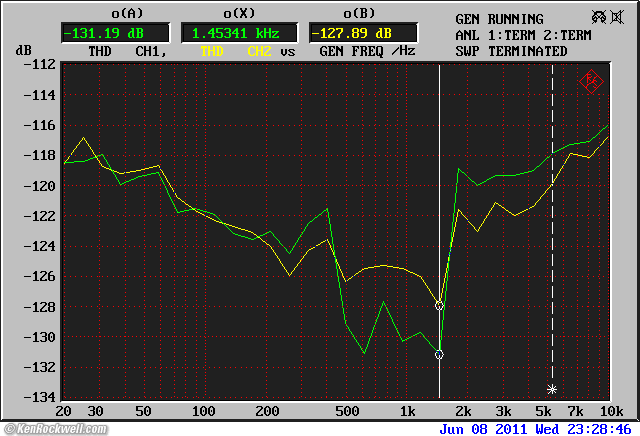
THD at 2.4V RMS, UPL low-distortion generator, balanced 600 Ω output, generator crossed AC input as read by UPL analyzer, 22 kHz bandwidth.
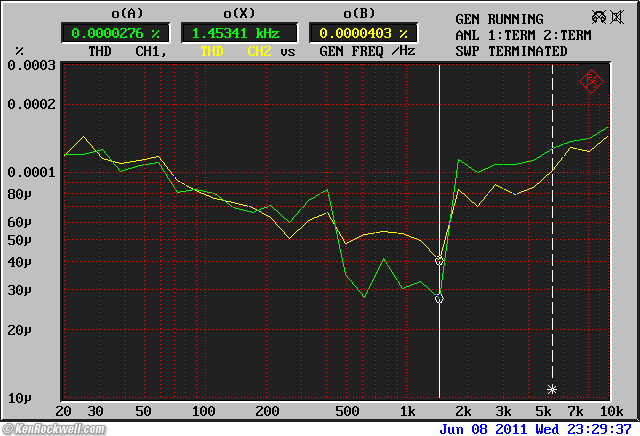
THD at 2.4V RMS, UPL low-distortion generator, balanced 600 Ω output, generator crossed AC input as read by UPL analyzer, 22 kHz bandwidth.
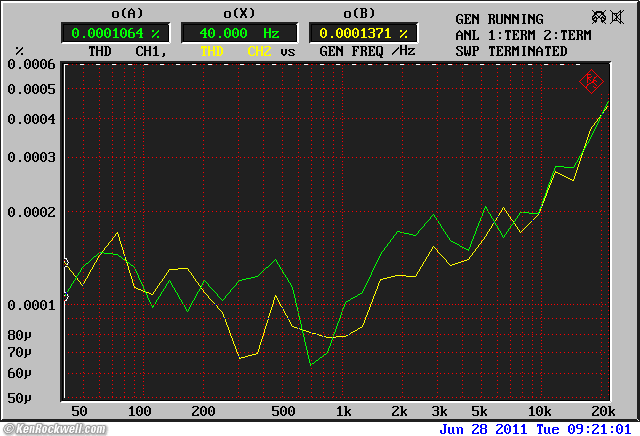
THD at 2.4V RMS, UPL low-distortion generator, unbalanced 5 Ω output, generator crossed AC input as read by UPL analyzer, 110 kHz bandwidth.
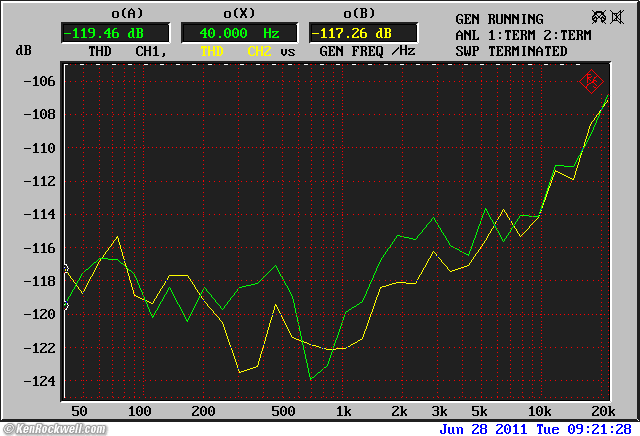
THD at 2.4V RMS, UPL low-distortion generator, unbalanced 5 Ω output, generator crossed AC input as read by UPL analyzer, 110 kHz bandwidth.
THD versus level, unbalanced out -> in
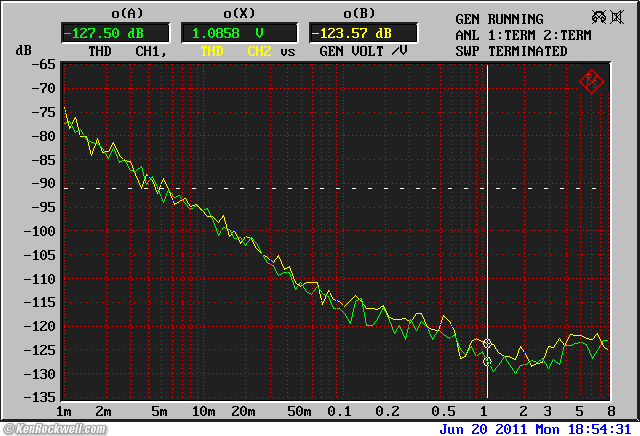
THD (D2-D9), UPL low-distortion generator, unbalanced 5 Ω output, 99¢ RCA cable, 22 kHz bandwidth.
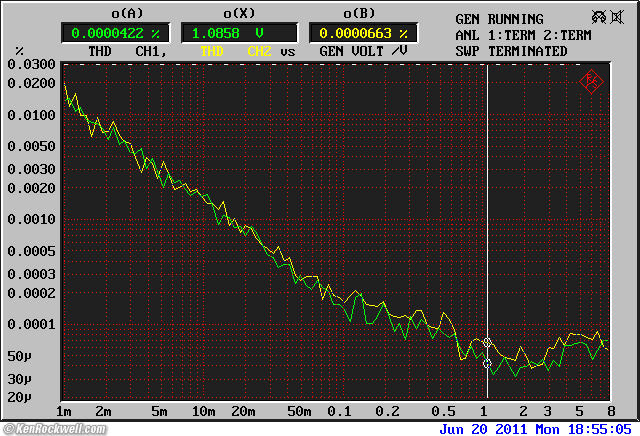
THD, same situation, percentage scale instead of dB.
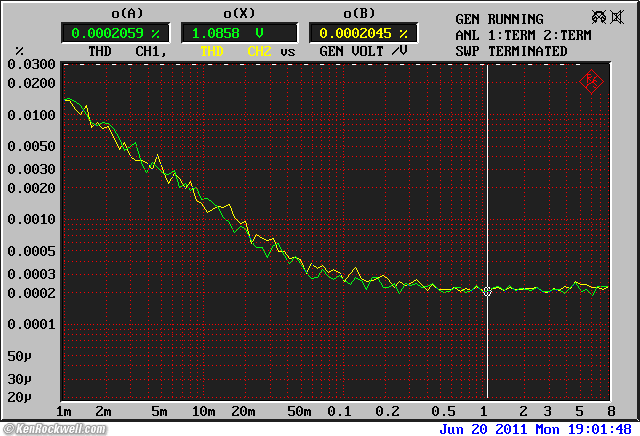
THD (D2-D9), UPL standard (DAC) generator, unbalanced 5 Ω output, 99¢ RCA cable, 22 kHz bandwidth.
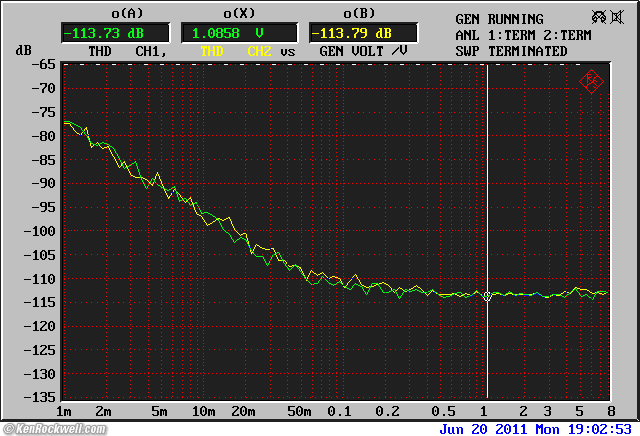
THD, same situation, percentage scale instead of dB.
THD+N versus level
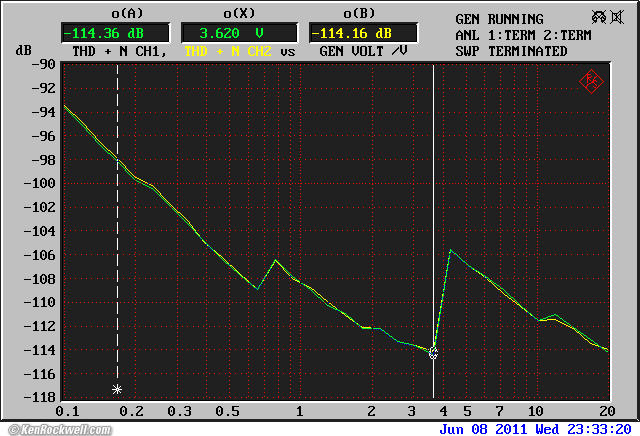
THD+N, UPL low-distortion generator at 1 kHz, balanced 600 Ω output, generator crossed AC input as read by UPL analyzer, 22 kHz bandwidth, dB. Channel 1 and Channel 2.
Low-Level Gain Linearity
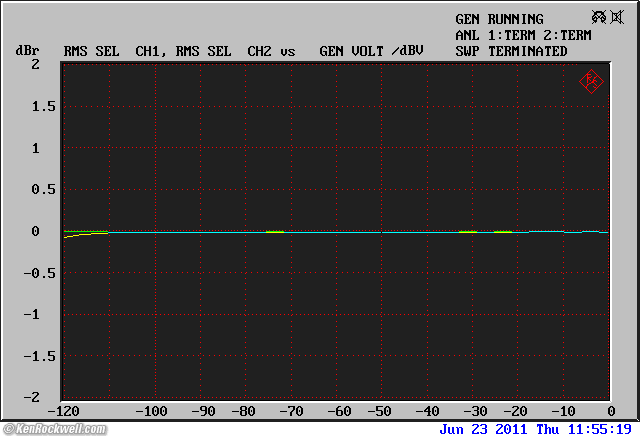
Measured gain versus level of a 99¢ RCA patch cord 1 kHz, Channel 1 and Channel 2. The low-level variation is really more of a function of for how long I'd like to wait for the noise to average.
Power Consumption
110 Watts, measured.
Clock Accuracy
Set OK 09 June 2011.
± <1s 16 June 2011
+0.3s 21 June 2011
+0.5s 28 June 2011 (about +1s in 38 days or about +300 ppb or +0.3 ppm/300ppb)
OK 18 July 2011
+2/3 second 29 July 2011 (about +1s in 75 days or +0.16 ppm / 160 ppb)
+1.5 s 12 August 2011
+2 s 30 August 2011
+12s 28 October 2011
+11s 14 December 2011
+12s 21 December 2011
+10s 09 Feb 2012
+20s 15 Mar 2012
+27s 22 June 2012
RESET 15 August 2012 after return from calibration at R&S where processor board was replaced. Jan 2013 off a couple of minutes.
Reset OK standard time 28 Jan 2013. OK from DOS, 4 seconds slow at UPL.
-1:16 17 May 2013. Reset OK to DST.
-26s 19 June 2013
-33s 01 July 2013
-151s = -2:31 18 April 2014 = -151/11 months = -165s/yr = -13.7s/mo
RESET +1m 18 April 2014
-16 29 July 2014
-38 28 Aug 2014 (-3/4s per day)
RESET +22s 28 Aug 2014
-39.3s 13 November 2014 (-0.796s/day)
RESET TO PST +30s 13 November 2014
-1:20 23 MARCH 2015 RESET TO PDT (slow 110 seconds/130 days = -846 mS/day)
+87s 23 March 2015
-2:51 01 February 2016
RESET TO PST
+29.25s 11:25AM 01 February 2016
-1:52 1111AM 20 July 2016 (-141s/5.7mo = -24.7s/mo)
RESET TO PST
+43 1116 20 July 2016
-11m 13 Sept 2018
RESET
+2.5mins 13 sept 2018
RESET to PST
-6 12 Jan 2019
-11:50 4pm 22 Jan 2021 (~12m/24mo=-30s/mo)
RESET
+2m37s 4pm 22 Jan 2021
+1.5m 02 Apr 2021, reset to PDT
+3:50 02 Apr 2021
+6s 29 Nov 2021 (-4m/8mo = -30s/mo), Reset to PST
+2s 29 Nov 2021
-6:55 20 Jan 2023 (~7m/14mo = -30s/mo)
RESET
+7:02 20 Jan 2023
![]()
The rest of this are notes to myself pending a complete review.
FILTERS (ANALYZER > FUNCTION > FILTER) let you use and listen to the filter, with B5.
great support! 888 TEST RSA
Dithering must be manually calculated, and for 16 bit, doesn't show on panel display (0.0000153)
OK to plug in keyboard after it's on
intelligent auto scaling and labeling.
try deleting DAI_, KEN -2011
Introduction top
Intro Specs Performance Compared Usage Recommendations
|
Adorama pays top dollar for your used gear. I buy only from these approved sources. I can't vouch for ads below. |
B-29 very limited functions
5dB steps analyzer
"dynamic mode precision" uses notch for TH
For over 30V, need analog board v4 and software v1
discontinued 2007, expect 5-10 yrs, thus 4 years from 2011
Much faster weeps with regular gen
For THD sweep fundamental detection, use GEN SYNC with std gen, AUTO with lo-dist.
Beeps after completing long sweep.
THD sensitivity defaults from 100 Hz , so set it to 10 Hz or so otherwise you'll not see THD below 50 Hz.
HDD will sleep.
Power switch is all you need to turn off or on. The computer watches out for itself; thee is no need wake or sleep it separately. One push of the power switch, and that's all that's needed.
Wakes up right where it left off.
GEN OFF button with LED is VERY handy when testing noise or working at high power.
Specifications top
Intro Specs Performance Compared Usage Recommendations
±
Ω
DOS 6.22
Software 1.22 (1998)
Setup 0.29
Analog board 4.07
Code 0.00
CPU Board 5.86
Dig board 0.01
8MB ram
B1 low distortion 0.01
B4 rem ctl INST
B2 digital 1.47
B5 spkr 1.46
B21 DA protocol
B22 DA jitter
B10 seq ctlr
B6 -NA-
ITU-T 033 -NA-
AMD K5
435mm wide, 192mm high, 475mm deep.
8.4" LCD
Updated to v 3.06 2.33PM 08 June 2011. Only took a few minutes, type UPLINST at the A: prompt.
External VGA monitor works great.
Now reads:
B1 0.01
B4 INST
B2 Dig Audio 1.47
B5 Speaker 1.46
B21 DA Prot INST
B22 DA Jitt INST
B23 Coded -NA-
B8 PhoneTst -NA-
B9 3G Tests -NA-
B10 SeqCtrl INST
B6 Coher -NA-
B33 ITU 033 -NA-
Versions
Software 3.06
Setup 0.33
Analog Board 4.07 - code 0.00
CPU board 5.86
Dig board 0.01
Weight
12.6 kg (27.8 pounds)
Compared top
Intro Specs Performance Compared Usage Recommendations
Usage top
Intro Specs Performance Compared Usage Recommendations
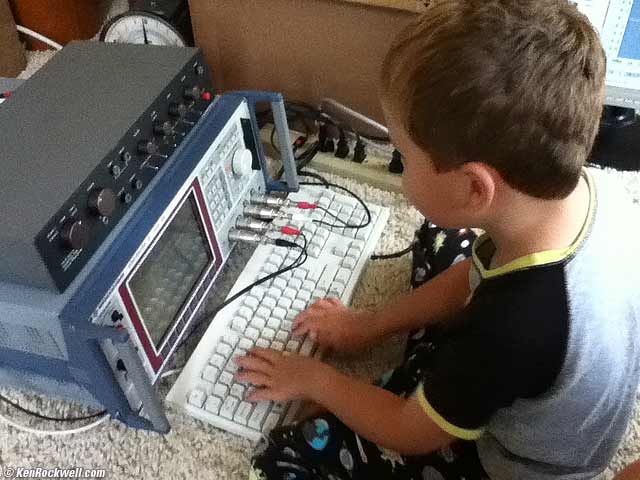
So well-designed that a four-year-old can make meaningful measurements. (21 June 2011, 8:08AM).
Getting Screen Shots
To get screen shots of setups and plots, first set it up in the OPTIONS panel. Chose the PCX file type. For destination and file name, under File Name enter "A:\FILENAME.PCX" to write to the floppy. If the last charactger is a digit, it will increment it if you want as you store more traces. For instance, for THD plots, I use file name A:\THD00001.PCX, and when it asks me to increment, each plot is stored as THD00001.PCX, THD00002.PCX, THD00003.PCX, etc.
Use 8 character or shorter file names. DOS only recognizes 8 characters for file names, so if you use a longer one, it will accept it, but truncate it when written to the floppy disc. If you use a longer file name and have a digit in the last place and ask it to increment as it writes to the floppy, it will increment, but since the incremented digit is truncated, the stored files will acrtually overwrite the earlier ones. Just keep file names at 8 characters or less, and no problem.
It will only increment for as many digits as you've left at the end of the file name. If you have 1 digit, you can write 10 files, or 100 files if you have two. If you run out of digits, it will stop recording files to the floppy; simply rectify the file naming back in the OPTIONS panel.
Don't use file names with spaces. The UPL will accept these entries, but DOS can't read them! If you do this and need to acess these files to rename or delete, use COPY xxx*.* to A:, delete using xx*.* from C, and then recopy the good files back to C:. In other words, use the UPL's internal computer to fix the problem so the files can be read elsewhere.
Hit "H COPY" on the front panel to write the screen to the floppy. Use a USB floppy drive, open file in Photoshop and save as GIF for web, only 15KB per screen, perfect 640-pixel-wide size, too!
If it seems to lock-up while writing to the floppy, just wait. If you're making many plots, it's faster to H COPY them to the C: drive, then go to SYSTEM and hit COPY *.PCX A: and let it copy the multiple traces to the floppy at once. If the floppy gets full, it just stops.
Formatting a floppy in Mac OS 10.6.7 in disc utilities as ERASE DISK as MS DOS isn't recognized by the UPL. Instead, format floppies in the UPL in its "SYSTEM" ( DOS computer) mode as C:>format a:.
Recommendations top
Intro Specs Performance Compared Usage Recommendations
Get one, I did.
Here's the original R&S UPL sales brochure.
© KenRockwell.com. All rights reserved.
Help me help you top
I support my growing family through this website, as crazy as it might seem.
The biggest help is when you use any of these links to Adorama, Amazon, eBay, B&H, Ritz, Calumet, J&R and ScanCafe when you get anything, regardless of the country in which you live. It costs you nothing, and is this site's, and thus my family's, biggest source of support. These places have the best prices and service, which is why I've used them since before this website existed. I recommend them all personally.
If you find this page as helpful as a book you might have had to buy or a workshop you may have had to take, feel free to help me continue helping everyone.
If you've gotten your gear through one of my links or helped otherwise, you're family. It's great people like you who allow me to keep adding to this site full-time. Thanks!
If you haven't helped yet, please do, and consider helping me with a gift of $5.00.
As this page is copyrighted and formally registered, it is unlawful to make copies, especially in the form of printouts for personal use. If you wish to make a printout for personal use, you are granted one-time permission only if you PayPal me $5.00 per printout or part thereof. Thank you!
Thanks for reading!
Mr. & Mrs. Ken Rockwell, Ryan and Katie.
Home Donate New Search Gallery Reviews How-To Books Links Workshops About Contact
